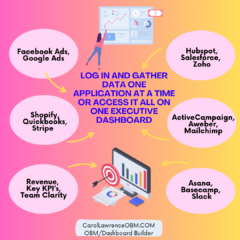Since print ads and other types of mass media are no longer as effective as they once were, digital marketing tactics are a must for most businesses. However, the same marketing tactics that work like gangbusters on Millennials won’t usually be as successful in targeting an older crowd. Here in the U.S., more than 10,000 people reach the retirement age of 65 each and every day. But now that people are living longer, that means that a greater portion of your customers are of an older demographic. In the digital age, it can be tough to reach this important audience. Sound familiar? These tips might make a huge difference in your strategy.
Create content that speaks to their concerns and needs.
First and foremost, you’ll need to illustrate why your product or service can improve your customer’s lifestyle. Seniors have different needs than, say, your Millennial customers, but that doesn’t mean they wouldn’t benefit from the same product; it’s really about how you communicate the way in which your brand can provide a solution. For seniors, it’s often effective to focus on how your service or product can enhance their independence, help them lead healthier lives, increase their security, benefit their relationships, or generally allow them to better enjoy their life. As a general rule, it’s usually best to zero in on their lifestyle, rather than financial concerns, although that may be appropriate in some cases.
In a recent survey, customers said that only 31% of the direct mail they receive includes personalized, useful content. With digital marketing, personal touches may be even harder to come by, even though there are ample ways to ensure a consumer feels they aren’t just one of thousands. Remember that a personal touch can go a long way, too. While there are certain fairly universal experiences many seniors share, utilizing some form of personalization in your marketing can be highly effective. For example, making customer service a major priority or relaying anecdotes to create a connection can be extremely beneficial when trying to reach senior consumers.
Emphasize the positive.
Many marketers struggle to reach those who are outside their own age group; after all, it’s hard to understand exactly what seniors want if you aren’t one yourself. One of the best pieces of advice is to really put yourself in their shoes: would you really want to buy a product that reminds you of your age and makes you feel old? Probably not. So when you’re marketing to Baby Boomers or older generations, don’t make age or declining health your main focus. Ultimately, it comes off as negative and won’t encourage someone of an older age demographic to make a purchase. Instead, frame your marketing as a way they can achieve their goals. Rather than making them question their own abilities, let them know how your service or product can make them feel empowered. After all, Inspired Magazine notes that you have just 10 seconds to make an impression and let Internet users know what they’ll get out of your website and company. When you make your audience feel capable, strong, and important, this will help them see that yours is a brand they should pay attention to.
Speak directly and honestly to them (not their children).
Seniors, like Millennials, will often see through an obvious sales pitch. Making false claims or attempts to mislead will not work out well. While some marketers think that they should try to market to seniors in more subtle ways, it’s actually a good idea to be forthcoming about who you’re trying to reach. Be clever and creative, of course, but don’t try to hide anything. A direct approach is key.
In addition, don’t make assumptions about who makes their decisions, purchase-related or otherwise. Even if you are promoting a product that can be helpful to caregivers, your marketing content should be geared towards seniors themselves, rather than their children or other familial caregivers. Remember that seniors are often healthy, strong, and fully capable of making decisions. If you’ve decided that your target demographic is mainly retirees, don’t write your copy with their kids in mind.
Tone and language shouldn’t be an afterthought.
Remembering to speak honestly and directly to your audience is important, but the tone you take and language you use to communicate your content is just as vital. How you refer to this demographic is a good place to start. Most seniors don’t mind being referred to as such, or as older adults or Baby Boomers, but they often take issue (and understandably so) with being called “elderly” or the use of any language that conveys frailty, inadequacy, weakness, or stupidity. Never be patronizing in feel. This may seem like a no-brainer, but you’d be surprised to find just how many marketers make this mistake.
You should also avoid utilizing cutting-edge language, catchphrases, or internet slang when you market to seniors. Millennials tend to love hyperbole and hashtags, but seniors don’t want either of those. In general, a no-nonsense yet tactful tone that avoids this kind of trendy terminology works best.
Make it simple and familiar, yet don’t be afraid to be different.
To that end, try to make it as easy as possible for seniors to understand your meaning and how to work with you. Rather than make them work hard to learn a new skill just to access your marketing or use your product, provide them with something that’s familiar to them. The more difficult you make it for them to read and understand what you do, the worse they’ll feel — and the less likely it’ll be that they’ll want to become a customer. For some companies, this means utilizing more traditional forms of marketing to complement their digital efforts. For others, it’s adequately communicating how simple a product is to use or exactly how it can benefit them.
Keep in mind that this doesn’t mean you can’t be creative. You absolutely should be. Many seniors are drawn to quirky, fun brands that aren’t afraid to take chances. The key is to relate that joie de vie directly to their own lifestyle. The connection should be simple, as should all of your marketing, the navigation of your website, and their entire purchasing experience.
While marketing to seniors in the digital age might have its challenges, it’s important to know that what you say and how you say it often matters most. And while seniors might not respond to social media marketing in the same way Millennials do, that doesn’t mean they don’t need your product. Focusing on how your company can enhance their life, rather than reminding them of their age, is usually the best route to take.
Kelsey R. is a writer and an avid world traveler. When she’s not writing or listening to 80s music, you can find her exploring different countries, taking selfies with her dog Lady, and in constant search for the perfect brownie recipe.









